Commonwealth of Virginia
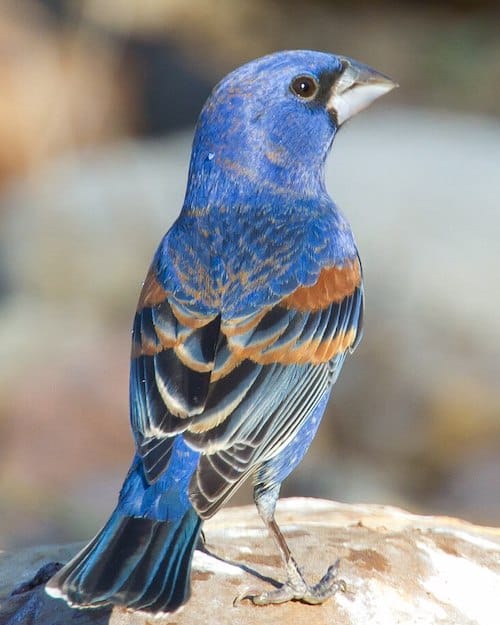
Virginia is a state in the Southeastern and Mid-Atlantic regions of the United States between the Atlantic Coast and the Appalachian Mountains covering almost 111,000 km2 (nearly 43,000 square miles). It has a population approaching 9 million people. The state’s capital is Richmond, but its most populous city is Virginia Beach with nearly half a million people. The Commonwealth is bordered by Maryland and Washington, DC to the north and east; by the Atlantic Ocean to the east; by North Carolina to the south; by Tennessee to the southwest; by Kentucky to the west; and by West Virginia to the north and west. Virginia’s boundary with Maryland and Washington, DC extends to the low-water mark of the south shore of the Potomac River.
Eastern Virginia is part of the Atlantic Plain, and the Middle Peninsula forms the mouth of the Chesapeake Bay. Central Virginia lies predominantly in the Piedmont, the foothill region of the Blue Ridge Mountains, which cross the western and southwestern parts of the state. The fertile Shenandoah Valley fosters the state’s most productive agricultural counties, while the economy in Northern Virginia is driven by technology companies and US federal government agencies, including the US Department of Defense and Central Intelligence Agency. Hampton Roads is also the site of the region’s main seaport and Naval Station Norfolk, the world’s largest naval base.
The Chesapeake Bay separates the contiguous portion of the Commonwealth from the two-county peninsula of Virginia’s Eastern Shore. The bay was formed from the drowned river valley of the ancient Susquehanna River. Many of Virginia’s rivers flow into the Chesapeake Bay, including the Potomac, Rappahannock, York, and James, which create three peninsulas in the bay, traditionally referred to as ‘necks’ named Northern Neck, Middle Peninsula, and the Virginia Peninsula from north to south. Sea level rise has eroded the land on Virginia’s islands, which include Tangier Island in the bay and Chincoteague, one of 23 barrier islands on the Atlantic coast.
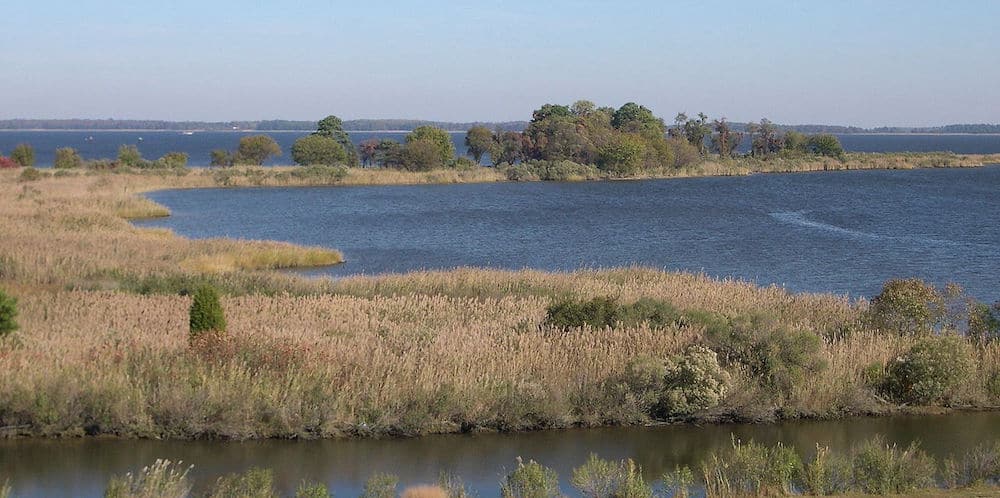
Chesapeake Tidal Wetlands – ©Jennifer Schmidt, Copyrighted free use, via Wikimedia Commons
The Tidewater is a coastal plain between the Atlantic coast and the fall line. It includes the Eastern Shore and major estuaries of Chesapeake Bay. The Piedmont is a series of foothills east of the mountains. The region, known for its heavy clay soil, includes the Southwest Mountains around Charlottesville. The Blue Ridge Mountains are part of the Appalachian Mountains with the highest points in the Commonwealth, the tallest being Mount Rogers. The Ridge-and-Valley region is west of the mountains and includes the Massanutten Mountain ridge and the Great Appalachian Valley, which is called the Shenandoah Valley in Virginia, named after the river of the same name that flows through it. The Cumberland Plateau and Cumberland Mountains are in the southwest corner of Virginia, south of the Allegheny Plateau. In this region, rivers flow northwest, with a dendritic drainage system, into the Ohio River basin.
Virginia has a humid subtropical climate that transitions to humid continental west of the Blue Ridge Mountains. Seasonal extremes vary from average lows of −4 °C in January to average highs of 30 °C in July. The Atlantic Ocean and Gulf Stream have a strong effect on eastern and southeastern coastal areas of the Commonwealth, making the climate there warmer but also more constant.
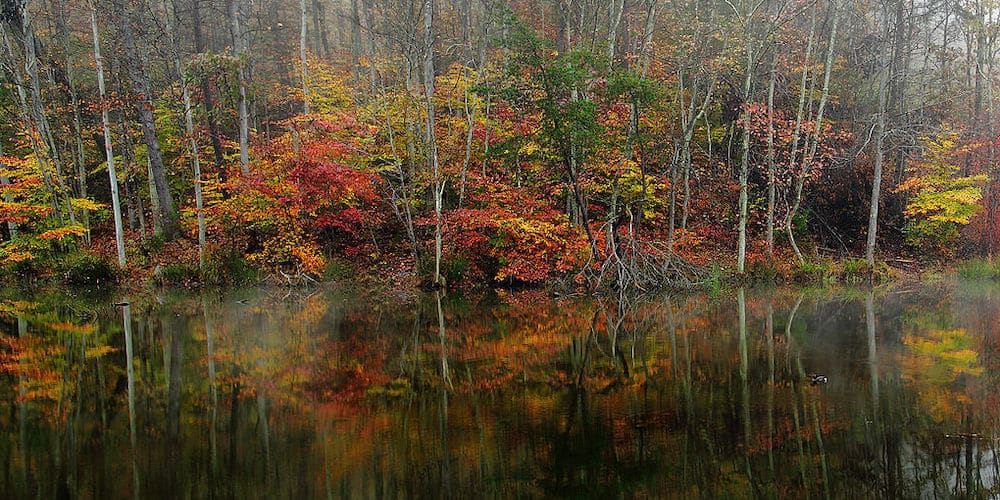
©Forest Wander CC BY-SA 3.0 US via Wikimedia Commons
Forests cover 62% of Virginia as of 2021, of which 80% is considered hardwood forest, meaning that trees in Virginia are primarily deciduous and broad-leaved. The other 20% is pine, with loblolly and shortleaf pine dominating much of central and eastern Virginia. In the western and mountainous parts of the Commonwealth, oak and hickory are most common, while lower altitudes are more likely to have small but dense stands of moisture-loving hemlocks and mosses in abundance. In the lowland tidewater and Piedmont, yellow pines tend to dominate, with bald cypress wetland forests in the Great Dismal and Nottoway swamps. Other common trees include red spruce, Atlantic white cedar, tulip-poplar, and the flowering dogwood, the state tree and flower, as well as willows, ashes, and laurels.
White-tailed deer, one of 75 mammal species found in Virginia, rebounded from an estimated population of as few as 25,000 in the 1930s to over one million by the 2010s. Native carnivores include black bears, who have a population of around five to six thousand in the state, as well as bobcats, coyotes, both grey and red foxes, raccoons, weasels and skunks. Rodents include groundhogs, nutria, beavers, both gray squirrels and fox squirrels, chipmunks, and Allegheny woodrats, while the seventeen bat species include brown bats and the Virginia big-eared bat, the state mammal. The Virginia opossum is also the only marsupial native to the United States and Canada, and the native Appalachian cottontail was recognised in 1992 as a distinct species of rabbit, one of three found in the state. Whales, dolphins, and porpoises have also been recorded in Virginia’s coastal waters, with bottlenose dolphins being the most frequent aquatic mammals. Virginia’s bird fauna consists of c.500 species, of which 359 are regularly occurring and 214 have bred in Virginia, while the rest are mostly winter residents or transients.
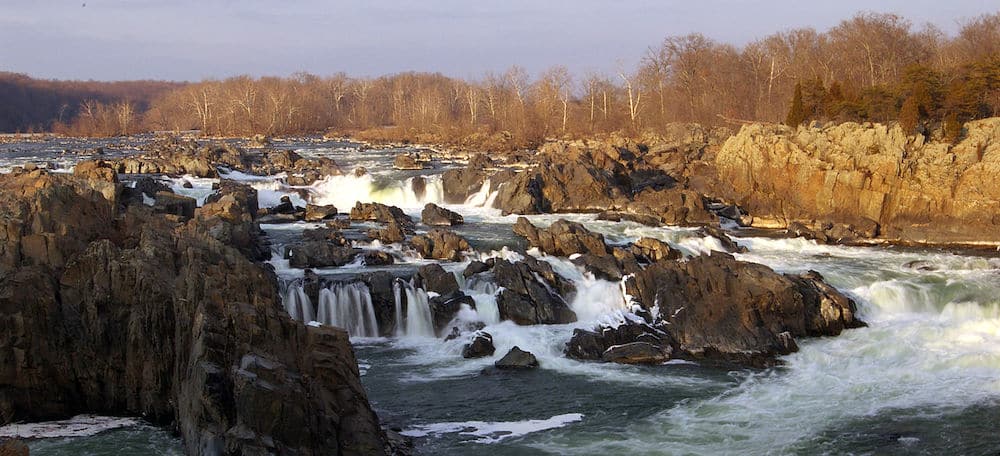
Great Falls Park Potomac River – ©MamaGeek CC BY 3.0 via Wikimedia Commons
As of 2019, roughly 16.2% of land in the Commonwealth is protected by federal, state, and local governments and non-profits. There are thirty National Park Service units in the state, such as Great Falls Park and the Appalachian Trail, and one national park, Shenandoah. The US Forest Service administers the George Washington and Jefferson National Forests, which cover more than 1.6 million acres (6,500 km2) within Virginia’s mountains, and continue into West Virginia and Kentucky. The Great Dismal Swamp National Wildlife Refuge also extends into North Carolina, as does the Back Bay National Wildlife Refuge, which marks the beginning of the Outer Banks. State agencies control about one-third of protected land in the state,[158] and the Virginia Department of Conservation and Recreation manages over 75,900 acres (307.2 km2) in forty Virginia state parks and 59,222 acres (239.7 km2) in 65 Natural Area Preserves.
Birding Virginia
Virginia’s bird fauna consists of c.500 species, of which 359 are regularly occurring and 214 have bred in Virginia, while the rest are mostly winter residents or transients. Water birds include sandpipers, Wood Duck and Virginia Rail, while common inland examples include warblers, woodpeckers, and cardinals, the state bird. Birds of prey include Osprey, Broad-winged Hawks, and Barred Owls. There are no species of bird endemic to the Commonwealth. Audubon recognises 21 Important Bird Areas in the state. Peregrine Falcons, whose numbers dramatically declined due to DDT pesticide poisoning in the middle of the 20th century, are the focus of conservation efforts in the state and a reintroduction program in Shenandoah National Park.
Virginia boasts varied avian habitats. The Atlantic beaches and coastal plain are especially rich in birdlife. This includes Virginia’s Eastern Shore, that peninsular extension from the north that borders the eastern aspect of the Chesapeake Bay. Habitats here include fresh-water and salt-water marshes, a variety of forests and cultivated fields.
A regional focal point for birders is the Chincoteague National Wildlife Refuge at Virginia’s border with Maryland. This Atlantic barrier island refuge harbours numerous species of waterfowl in the winter and is visited by a great variety of migrating shorebirds in late summer and early fall. Specialties include Hudsonian Godwits, Wilson’s Phalaropes, American Golden-plover, American Avocets, Buff-breasted Sandpipers and Black-necked Stilts. Brown-headed Nuthatches are permanent residents in the Loblolly Pine forests.
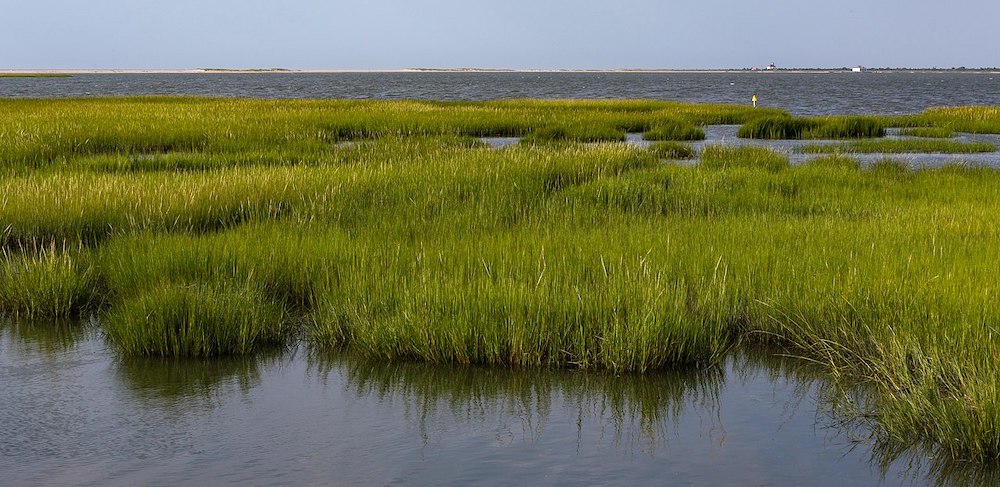
Chincoteague National Wildlife Refuge – US Fish and Wildlife Service, Public domain, via Wikimedia Commons
South of Chincoteague the Virginia Coast Reserve represents a chain of barrier islands and is a designated International Biosphere Reserve for shorebird protection. Accessible only by boat this area is best visited with pre-arranged group tours. Threatened and endangered species, such as Piping Plover, nest in this reserve. South of the mouth of the bay is the southern coastal plain where some of the northernmost bald cypress swamps on the east coast are located in areas like First Landing State Park and the Great Dismal Swamp. Spring is considered the best birding season here, when many warblers and other Neotropical migrants pass through. Prothonotary Warblers and Wood Ducks nest here. There are many other islands of preserved habitat within this popular summer resort area and well-populated region.
The broad piedmont includes population centres like Richmond and the broad urban sprawl outside of Washington DC. Yet within this busy human habitat there are a surprising number of great birding sites. Huntley Meadows Park and Mason Neck State Park are two fine refuges in Fairfax County, along the Potomac River and just outside the US Capital beltway. Summering Least and American Bitterns, Yellow-crowned and Black-crowned Night-herons and King Rails are special attractions at Huntley Meadows while Mason Neck State Park is known for nesting Bald Eagles and Great Blue Heron rookeries. James River Park, within the city limits of Richmond, has recorded 20 species or warblers in one day during peak spring migration.
The non-metropolitan region of the piedmont is a mix of small towns, agricultural habitats, patches of mixed deciduous and pine forests and is traversed by several large rivers and dotted with a few man-made lakes. The largest man-made lake, the 50,000-acre John H Kerr Reservoir, borders on North Carolina in the south central part of the state. Much of the shoreline is accessible by vehicle. Wintering waterfowl, loons (divers) and grebes can be found here, although spring birding is perhaps best. Cliff Swallows, Blue Grosbeaks, Summer Tanager and Loggerhead Shrikes are known to breed around the lake. North and towards the mountains, just outside the city of Charlottesville, is a protected area of woodlands, streams, marshes and farm fields known as the Ivy Creek natural Area. Wild Turkeys are permanent residents here. Woodland species such as migrant thrushes, vireos and warblers (up to 31 species) are common.
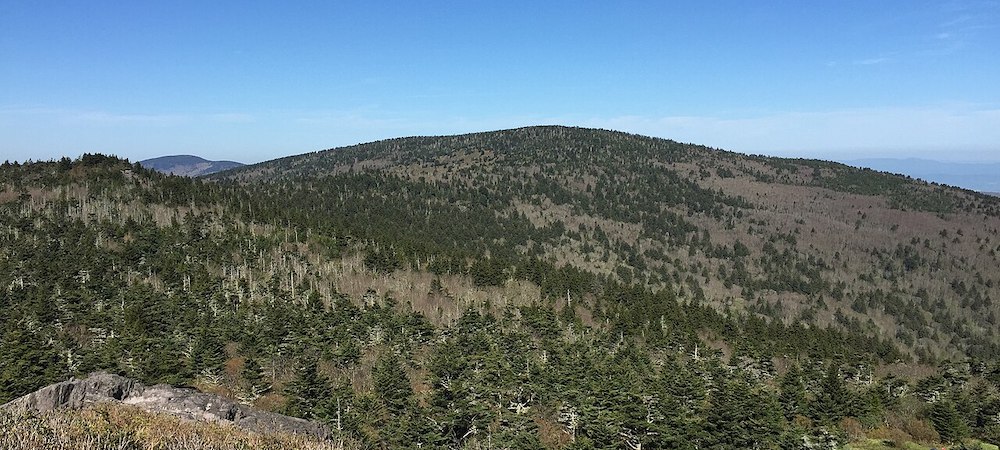
Mount Rogers – ©Famartin CC BY-SA 4.0 via Wikimedia Commons
The western mountains of Virginia include the Blue Ridge and the Alleghenies. Between these ranges lies the broad and beautiful Shenandoah Valley. Virginia’s highest point, Mt. Rogers is near the southwest corner of the state. Such high elevation areas are unique in Virginia in that, otherwise northern birds such as Saw-whet Owl, Hermit Thrush, Magnolia Warbler, Alder Flycatcher and Yellow-bellied Flycatcher, breed here. If one is in this part of Virginia during the month of May, perhaps the best birding is along the Blue Ridge Parkway. This scenic route offers ideal chances for many migrating and resident warblers as well as Rose-breasted Grosbeaks, Veeries and Woodthrush. Key stops along this route might include Warbler Road in Boteourt county and Humpback Rocks in Augusta County.
In the fall one of the best places in the state for observing migrating hawks, especially large numbers of Broad-winged Hawks, is at Rockfish Gap where the northern terminus of the Blue Ridge Parkway transitions with Shenandoah National Park near the town of Waynesboro. Shenandoah National Park itself offers great mountaintop scenery and fantastic spring and summer birding.
-
Number of bird species: 504
(As at August 2024)State Bird: Northern Cardinal Cardinalis cardinalis
-
Avibase
PDF ChecklistThis checklist includes all bird species found in Virginia , based on the best information available at this time. It is based on a wide variety of sources that I collated over many years. I am pleased to offer these checklists as a service to birdwatchers. If you find any error, please do not hesitate to report them. -
Birds of Albemarle County
PDF ChecklistChecklist of Birds in Albemarle County and Charlottesville Compiled by Piedmont Virginia Bird Club -
Northern Virginia Bird Alliance
PDF ChecklistThe Checklist of Birds of Northern Virginia was created to assist birders in the area covered by our Audubon chapter. -
Virginia Society of Ornithology
Annotated ListThe Birds of Virginia and its Offshore Waters: The Official List -
Wikipedia
Annotated ListThis list of birds of Virginia includes species credibly documented in the U.S. state of Virginia by the Virginia Avian Records Committee of the Virginia Society of Ornithology (VARCOM). As of January 1, 2022 the list contained 487 species and four species pairs.[1] Of them, 109 are considered accidental. Seven species were introduced to North America, one is extinct, and one has been extirpated. -
eBird
PDF ChecklistThis checklist is generated with data from eBird (ebird.org), a global database of bird sightings from birders like you. If you enjoy this checklist, please consider contributing your sightings to eBird. It is 100% free to take part, and your observations will help support birders, researchers, and conservationists worldwide.
-
Birder's Guide to Virginia
| (Aba Birdfinding Guide)| by David W. Johnston, David W. Johnston | American Birding Association | 1997 | Spiralbound | 288 pages, black & white illustrations, tables, maps | ISBN: 9781878788122 Buy this book from NHBS.com -
Birds of Virginia
| By Todd Telander | Falcon Guides | 2012 | Paperback | 96 pages, colour illustrations | ISBN: 9780762778935 Buy this book from NHBS.com -
Birds of Virginia Field Guide
| By Stan Tekiela | Adventure Publications | 2021 | Edition 2 | Paperback | 392 pages, colour photos, colour distribution maps | ISBN: 9781647552022 Buy this book from NHBS.com -
The History of Ornithology in Virginia
| By David W Johnston | University of Virginia Press | 2003 | Hardback | 256 pages, 25 b/w illustrations, 7 tables | ISBN: 9780813922423 Buy this book from NHBS.com -
Virginia Birds
| (A Folding Pocket Guide to Familiar Species) | By James Kavanagh & Raymond Leung | Waterford Press | 2000 | Unbound | 12 pages, colour illustrations, 1 colour map | ISBN: 9781583550991 Buy this book from NHBS.com
-
Great Dismal Swamp Birding Festival
InformationJoin us for a weekend of guided bird walks, natural history talks, live animals and family fun activities! All events are free. Registration required for Guided Walks and Bus Tours and recommended for Presentations. Please check the registration website often as spots open up when there are cancellations. We look forward to seeing you at the refuge! -
Great Dismal Swamp Birding Festival Event
InformationJoin us for a weekend of guided bird walks, natural history talks, live animals and family fun activities! All events are free. Registration required for Guided Walks and Bus Tours and recommended for Presentations. Please check the registration website often as spots open up when there are cancellations. We look forward to seeing you at the refuge! -
Virginia Birding Classic
InformationThe Virginia Birding Classic is a statewide birding competition in which teams of birders search the public lands of Virginia every spring for as many species as they can find in 24 hours. -
Virginia Osprey Festival
InformationThe Virginia Osprey Festival is one of the largest festivals of its kind celebrating the return of the osprey to Colonial Beach, birdwatching and the area’s abundant natural resources.
-
Coastal Virginia Wildlife Observatory
Observatory WebsiteSatellite ViewWelcome to the Coastal Virginia Wildlife Observatory blog for postings of programs, activities and photos of unusual birds and butterflies around Virginia. To LEARN more about our nonprofit work, SUBSCRIBE to our monthly newsletter, and SUPPORT us, visit our website at www.vawildliferesearch.org. "Protecting Wildlife through Field Research, Education and Habitat Conservation for Over 25 Years" -
Harvey’s Knob Hawkwatch
Observatory WebsiteSatellite ViewLocated on the Botetourt-Bedford County line near Roanoke, Virginia between mile markers 95 and 96 on the Blue Ridge Parkway… -
Kiptopeke Environmental Station
Observatory WebsiteSatellite ViewOur focus, historically has been the study of fall bird migration at what is now Kiptopeke State Park. This will continue to be our most visible activity but by no means is this our only interest. We support the study of birds and insects elsewhere on the lower Eastern Shore. We also actively support the systematic efforts of the Center for Conservation Biology and the Coastal Resource Management Program to identify and preserve critical habitat. Several of the recent and planned K.E.ST.R.E.L. efforts incorporate this broader focus… -
Occoquan Bay Bird Banding Station
Observatory WebsiteSatellite ViewVisiting the bird banding station is a great way to see migratory song birds up close and to learn about their activity on the refuge, and other interesting facts about identification and behavior. -
Richmond Audubon
Observatory WebsiteSatellite View -
Rockfish Gap Hawk Watch
Observatory WebsiteSatellite ViewRockfish Gap Hawk Watch is held on the grounds of the Inn at Afton, located on the southern side of Rockfish Gap in the Blue Ridge Mountains, just above where I-64 (exit 99) intersects with the southern end of the Skyline Drive and the northern end of the Blue Ridge Parkway, just east of Waynesboro, VA and approximately 22 miles west of Charlottesville, VA. This is one of the best places in Virginia to witness the annual southward migration of diurnal raptors. On most weekends from mid August to late November volunteer birders staff this observation site and keep a running total of the raptor species seen. September is the best month to witness large kettles of migrating Broad-winged Hawks. Daily counts can go into the thousands during such phenomena. Eighteen species of hawks, falcons and eagles have passed over this site during the past few decades since records have been kept. Some interesting and surprising passerine and other non raptor migratory species also pass by here.
-
Atlantic Wildfowl Heritage Museum
WebsiteThe Atlantic Wildfowl Heritage Museum, located in the historic de Witt Cottage on the Virginia Beach oceanfront, displays art and artifacts documenting migratory wildfowl that pass through Eastern Virginia. Exhibits of wildfowl and shorebird carvings trace the evolution of this American art form from the simple traditional decoys to the contemporary lifelike carvings. -
Virginia Museum of Natural History
WebsiteSupport Virginia Museum of Natural History in its mission to reach families, schools, visitors and businesses across the Commonwealth and beyond.
-
Audubon Society in Virginia
WebpageChapters enable Audubon members and others to meet and share an appreciation of their common interests. They create a culture of conservation in local communities through education and advocacy, focusing on the conservation of birds, other wildlife and conservation of important habitats. -
Augusta Bird Club
WebsiteThe AUGUSTA BIRD CLUB was founded in 1966 and currently includes about 190 members from Augusta County, Staunton, and Waynesboro, Virginia, as well as nearby areas. Monthly meetings are conducted Sep-May in Staunton that includes a Program by an invited speaker. -
Birding Virginia
WebsiteThe seeds for Birding Virginia were planted in 2017 by a group of birders who all enjoy statewide county birding. -
Bristol Bird Club
Facebook PageThe Bristol Bird Club was founded in Bristol, Tennessee, Bristol, Virginia in 1950 to promote the enjoyment, scientific study and conservation of wild birds. -
Buchanan County Bird Club
WebsiteEvents, newsletter, members etc. etc… -
Cape Henry Audubon Society
Facebook PageDespite promise after promise, Virginia is quickly losing its nontidal wetlands, STATEWIDE. But an exciting turn Monday night could be the beginning of a turnaround. A responsible bill to stop the destruction was approved in committee by the House of Delegates by 10-7, to many people's surprise. Virginia Audubon's testimony helped make it happen. -
Fairfax Audubon Society
WebsiteThe Fairfax Audubon Society, the local chapter serving Northern Virginia, is committed to the Audubon mission, which is to conserve and restore natural ecosystems, focusing on birds and other wildlife, and their habitats -
Lynchburg Bird Club
WebsiteThe Lynchburg Bird Club was founded in April, 1958 under the guidance of Dr. Ruskin Freer, a biology professor at Lynchburg College. But birding in Lynchburg goes back much earlier in the twentieth century when many of the original members of the Virginia Society of Ornithologists (VSO) lived and birded in the Lynchburg area… -
Nature Conservancy in Virginia
WebsiteExcellent photo of Buffalo mountain on the opening page. Welcome to The Nature Conservancy of VirginiaVirginia is a remarkable state: a mosaic of wild beaches and pristine estuaries, ancient mountains and fertile valleys, northern forests and southern swamps. From the Appalachians to the Atlantic, from the Blue Ridge Mountains to the Chesapeake Bay, The Nature Conservancy is working to protect these rare, diverse, and beautiful natural landscapes… -
Nature Forward
WebsiteDuring their October 20, 2022 Annual Meeting, members enthusiastically approved Nature Forward as the new name of the former Audubon Naturalist Society. Our 125-year-old organization remains committed to our mission to inspire people across our region to appreciate, understand and protect their natural environment. Our vision, to create a larger and more diverse community of people who treasure the natural world and work to preserve it, remains the same. -
New River Valley Bird Club
WebsiteWe are a chapter of the Virginia Society of Ornithology dedicated to the enjoyment and understanding of the Commonwealth's nearly 500 bird species. -
Northern Neck Audubon Society
WebsiteThe Northern Neck of Virginia, located between the Potomac River to the north and the Rappahannock River to the south, is home to some truly great birding. Because of its proximity to the Chesapeake Bay, its large expanses of undeveloped land and wetlands, and the passion of the local community to protect and preserve its natural treasures, the four counties of the Northern Neck are a haven for over 250 species of birds. -
Northern Shenandoah Valley Audubon Society
WebsiteAbout Right here in the Shenandoah Valley, we're defending Earth's biological diversity. By conserving and restoring natural ecosystems----focusing on birds and their habitat----we benefit both wildlife and humanity. -
Northern Virginia Bird Alliance
WebsiteOur mission is to engage all Northern Virginia communities in enjoying, conserving, and restoring nature for the benefit of birds, other wildlife, and people. We advance our mission through educational programs, citizen science, conservation initiatives, and advocacy initiatives. We envision a world where people, wildlife, and their habitats thrive. -
Northern Virginia Bird Alliance
WebsiteOur mission is to engage all Northern Virginia communities in enjoying, conserving, and restoring nature for the benefit of birds, other wildlife, and people. We advance our mission through educational programs, citizen science, conservation initiatives, and advocacy initiatives. We envision a world where people, wildlife, and their habitats thrive. -
Piedmont Virginia Bird Club
Websitehe Piedmont Virginia Bird Club is an informal group of about 200 people who join together to share their enthusiasm for birds. The 2024-2025 season marks our club’s thirty-ninth anniversary. -
Richmond Audubon Society
WebsiteYou're invited to become active in the Richmond Audubon Society! Join us on bird walks. Come to meetings. New folks are always welcome. Novice birders are invited on all walks! Check out our activities at the left to see what's happening. Our Mission Statement The Richmond Audubon Society promotes the enjoyment, understanding, and preservation of birds, other wildlife, and habitat through birding, education, advocacy, and fellowship -
Roanoke Valley Bird Club
WebsiteMembers receive a monthly newsletter, our source of information about upcoming programs and field trips as well as the latest in birding facts and news. Membership is not required to take part in club meetings or club activities. -
Rockingham Bird Club
WebsiteThe purpose and object of this club is to promote interest in the study of birds, and in the conservation of birds and other natural resources. -
Virginia Avian Records Committee (VARCOM)
WebsiteThe Virginia Avian Records Committee (VARCOM) was formed in 1989 to increase knowledge of Virginia birds, to evaluate and to archive records of vagrants and rare nesting species in the state, and to encourage high standards of observation, recording, and reporting in the birding community. -
Virginia Beach Audubon Society
WebsiteThe Virginia Beach Audubon Society is a local chapter of the National Audubon Society. VBAS is an active conservation and environmental organization dedicated to the Audubon cause of saving birds, wildlife, and habitat... -
Virginia Bluebird Society
WebsiteThe Virginia Bluebird Society (VBS) was founded in 1996 to promote bluebirds and other native cavity nesters. VBS is affiliated with The North American Bluebird Society (NABS) and is a Chapter of the Virginia Society of Ornithology (VSO). -
Virginia Important Bird Areas
WebsiteProgram - A science-based public, university and government partnership, defining and conserving through education Virginia habitat critical to North American birds -
Virginia Society of Ornithology
WebsiteThe Virginia Society of Ornithology is a nonprofit organization dedicated to the conservation of Virginia’s birds through research and education, and by connecting people of all genders, races, identities, and abilities who enjoy birds.
-
*Protected areas of Virginia
InformationSatellite ViewArboreta, Parks, Trails, forests etc... -
*Virginia Natural Area Preserves
InformationSatellite View -
CP Accotink Creek & Lake Accotink Park
InformationSatellite ViewAccotink Creek runs through one of the finest remaining wildlife corridors in Fairfax County. It is easily accessed from Wakefield, Eakin, and Lake Accotink Parks. There are miles of trails through good habitat that is excellent for bird watching, especially during migration. -
CP Huntley Meadows
WebsiteSatellite ViewNestled in Fairfax County's Hybla Valley, Huntley Meadows Park is a rich, natural island in the vast suburban sea of Northern Virginia. Its 1,424 acres harbor majestic mature forests, wildflower speckled meadows and acres of wetlands bursting with life. It is ideal wildlife habitat for beaver, otter, heron, ducks, deer, many songbird and butterfly varieties, as well as a host of other animals. -
NWR Back Bay
WebpageSatellite ViewEstablished in 1938 to provide habitat for migrating and wintering waterfowl, Back Bay National Wildlife Refuge is located in the southeastern corner of Virginia. The refuge is an important link in the chain of national wildlife refuges located along the Atlantic Flyway. Back Bay Refuge contains 7,732 acres, situated on and around a thin strip of coastline typical of barrier islands found along the Atlantic and Gulf coasts. Habitats include beach, dunes, woodland, farm fields and marsh. -
NWR Chincoteague
WebpageSatellite ViewAbout 300 species of birds have been identified on the Chincoteague National Wildlife Refuge. The Eastern Shore and the islands of Chincoteague and Assateague are located along the Atlantic flyway for shorebirds, waterfowl, and others that nest in the north and migrate south for the winter. The salt marshes, the pine woods, and the specially-developed, freshwater impoundments on the refuge are also nesting places for a variety of birds including species of plovers, gulls, terns, geese, herons, and ducks. -
NWR Great Dismal Swamp
WebpageSatellite ViewLocated in south-eastern Virginia and north-eastern North Carolina, the Great Dismal Swamp National Wildlife Refuge was formed in 1974 when Union Camp Corporation donated 49,100 acres of forested wetlands to The Nature Conservancy. This land was then conveyed to the Department of the Interior, and the Refuge officially established. The Refuge consists of over 107,000 acres, with Lake Drummond, a 3,100 acre natural lake… -
WRs Dyke Marsh
WebpageSatellite ViewDyke Marsh is one of the largest remaining freshwater tidal wetlands in the Washington metropolitan area. Its 485 acres of tidal marsh, floodplain, and swamp forest can be explored by boat or on foot.
-
VA Notable Bird Sightings & Discussion Group
Sightings & DiscussionVA Notable Bird Sightings & Discussion Group is designed as a place to post information related to sightings of rare or unusual birds in Virginia. It is also an appropriate place for discussion about notable bird sightings. -
VA-Bird
Mailing ListVA-BIRD is a birding communications network covering the entire state ofVirginia where you can:* report and receive rare bird sighting information* share timely information about bird outings and chapter field trips* interact with members of the National Audubon Society, Virginia Societyof Ornithology, and other bird-related organizations. -
Virginia Rare Bird Alert
SightingsThe report below shows observations of rare birds in Virginia.
-
Assateague Tours
PelagicsChincoteague and Assateague Birdwatching Boat Tour. We are the only tour boat that specializes in birdwatching tours. We will take you to the most remote areas of the islands to spot the unique and beautiful native birds. We travel through the marshlands and waterways around the barrier islands for a true island experience. -
Beach Birding
PelagicsI hope everyone is excited about the upcoming pelagics as I am! In light of those trips, I wanted to bring to everyone's attention a new eBird hotspot which has been created to help improve reporting on Virginia Beach pelagic trips. -
Bird Treks
Tour OperatorBird Treks has been providing small group and custom birding tours for over 20 years. Visit their website to see the incredible tours available, including Chincoteague National Wildlife Refuge in Virginia! -
Rudee Tours
PelagicsExperience the diversity the offshore waters off of the Mid-Atlantic have to offer as we head to the deep for our latest exploration! Norfolk Canyon, about 70 miles offshore, is a unique biological community teeming with wildlife. -
Ventures Birding Tours
Tour OperatorCome and join us on a short and sweet winter getaway to Virginia’s Eastern Shore and Chesapeake Bay area in search of waterfowl and other overwintering birds.
-
2015 [05 May] - John Rowlett, Tom Johnson, and Jan Pierson - Virginia's Warblers
Report...Here, along the banks of the James at Warren Ferry and the Hardware River WMA, such lowland, southern species as Prothonotary Warbler, Yellow-throated Warbler, Orchard Oriole, and Blue Grosbeak graced us with appearances. The birding didn't stop for dinner, either - a Louisiana Waterthrush arrived in a small stream next to our restaurant and sang from mere feet away as we dined.
-
Assateague Inn
AccommodationOpen year round with each season having it`s own special beauty and attraction. Assateague Inn is nestled among loblolly pines overlooking a small salt water creek and quiet salt marsh. Observe salt marsh wildlife from your room. Watch the sun rise, swim in our pool, relax in our hot tub, go crabbing on our deck, have a picnic and cook out on our charcoal grills. Leave your problems behind on the mainland and come to our beautiful island. Walk our beautiful beaches and trails, go bird watching, see our world famous Wild Ponies, and enjoy our friendly small town atmosphere -
Cornerstone Farm B&B Farmstay - Red Oak
AccommodationSpring 2004 we will be opening our farm as a Farmstay Bed & Breakfast. Watch for details as we prepare and get ready to accommodate our first guests to share the joys of country farm living. Some activities we will have at the farm for our guests will include: hiking, fishing, birding, and nature walks - to name just a few. -
Sevenoaks Retreat Center - Madison
AccommodationSurrounding the central campus of the retreat center are 120 acres of mostly forest wilderness, untouched for over 35 years, protected by an Open Space Easement from any future development. The woods, pond and river are abundant with wildlife--including deer, fox, raccoons, beavers and otters. Sevenoaks is also a bird watchers' paradise--redtail hawks, owls, herons, & numerous species of songbirds are commonly seen. We honor the wisdom of this land and of its natural inhabitants, and know that the land provides a deeply nourishing environment for all those who come here for their own healing and awakening…
-
Assateague Island Birds
WebpageLocated along the Atlantic migratory flyway, Assateague Island plays host to a wide variety of both migratory and resident bird species. Because its mid-latitude location is within the migratory routes of both northern and southern species, the island provides a unique opportunity for birders. The island's rich mosaic of forest, dune, and marsh habitats offers feeding and nesting opportunities for a wide array of shorebirds, songbirds, raptors, waterfowl, and waders. -
Center for Conservation Biology
WebsiteThe Center for Conservation Biology is a research and education organization within the Department of Biology at the College of William & Mary. Our particular focus is the development of information resources needed for effective, science-based conservation. We believe that information is the currency that drives all aspects of conservation… -
Delmarva Birding Weekends
WebsiteSightings and adventures in birding on the Delmarva Peninsula… -
My Bird Book Virginia
WebpageI am a beginning birder and a casual photographer, located in York County, Virginia… -
Virginia Bird & Wildlife Trail
WebpageIt’s easy to discover Virginia’s wild side with The Virginia Bird and Wildlife Trail (VBWT), an organized network of outdoor sites highlighting the best places to see birds and wildlife in the Commonwealth. -
Virginia Department of Game & Inland Fisheries
WebsiteSignpost site with some useful links for wildlife…
-
Ezra Staengl - BirdsAndBuds
BLOGThis blog is a collection of my birding and planting adventures in the piedmont region of central Virginia and beyond. I am a fourteen year old birder with a interest in botany, especially native plants, and orchids in particular. I’m also interested in Odonata (dragonflies and damselflies), as well as in birds of course! All photographs on this blog that do not say otherwise are mine. Thanks for visiting!
-
Photographer - Rob Paine - I See Beauty All Around
Photo BLOGRob Paine picked up his first camera before he turned seven. He rarely has been seen without one in his hands since. He inherited is love of photography from his Dad, who was a talented amateur photographer. Rob began his professional photography career while still in high school by shooting youth soccer games for local weeklies in Fairfax, Va…

